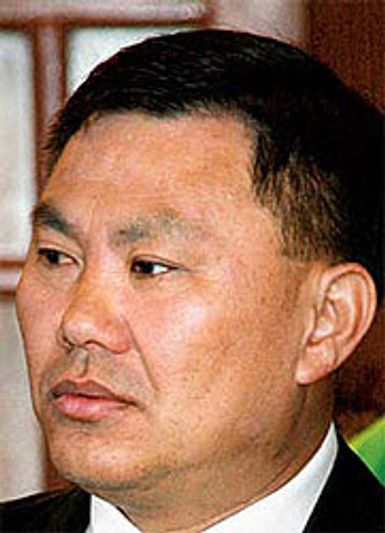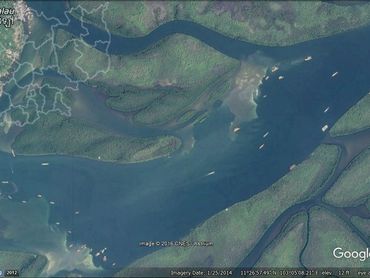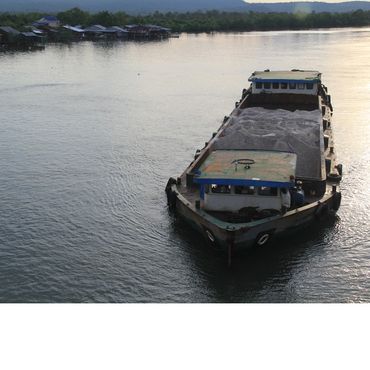
SAND MINING SCAMS
The Cambodian government has become infamous across the world, not just for its persecution of political and civil society leaders, but also for relentlessly, and in most cases illegally, selling the country's natural resources to the highest bidder.
In total violation to the country's constitution, laws, and international treaties it has signed, the Hun Sen government continues to allow and encourage, the over-exploitation of the nation's forests, land, rivers, estuaries, lakes and seas. The ultimate aim appeared to be to continue enriching the ruling elite.
In return, state finances receive pitiful revenue from such operations and local communities are left far worse off than before these so-called 'development projects' started. Needless to say Cambodia's environment - from which the majority of the population depends - continues to suffer some of the worst degradation found globally. The mining of sand since 2008, is a good example of corrupt practices that continue to decimate the environment. Meanwhile crooked officials siphon off revenue, much needed by the population. Corrupt government officials and their crooked business partners have used key state agencies and ministries to exploit the situation. The taxation department, law enforcement agencies, and the courts have all been involved in providing a false veneer of legality to the sand mining industry, while critical voices including the political opposition have been silenced. Activists from local communities, the media, and civil society have all faced fines, exile, beatings and imprisonment for seeking to tell the truth.
The deficit of reliable, accurate and truthful information and media sources, means that all too often Cambodians are left in the dark about important issues that might affect them, like sand mining. Their opinions, rights, and well-being are completely ignored and they are denied participation in even the most basic democratic processes. Often local people, especially in remote areas, are coerced and have little choice but to support the ruling party, often against their better judgement, and despite the connection with the party and the over-exploitation of natural resources happening near their homes that is bringing about economic havoc onto them.
Three main kinds of sand are being extracted in Cambodia:
1. Marine sand - extracted from coastal estuaries and used for land-reclamation. The vast majority was exported to Singapore;
2. River sand – used domestically in the construction sector, mainly for filling in lakes near major cities but also for concrete;
3. Silica sand - only for exports for countries like Taiwan for a diverse array of industries such as glass and electronics.

MARINE SAND
In 2008 the beautiful tranquility of Cambodia’s coastal estuaries was shattered by an invasion of sand dredging ships {1}. When local fishing communities complained that the presence of countless sand-transporting barges and dredges was seriously affecting the marine environment from which they largely-depended, they were told by local governments that the mining was legal, as it had been approved by the Cambodian government {2}.Those who asked too much were outright threatened.The little that the Hun Sen government said publicly about this was that Koh Kong's coastal estuaries carried 'too much sand', and as such needed to be deepened for navigational purposes, and to reduce riverbank erosion and floods in the area {3}. In short, that the dredging was officially done for the benefit of the fishing communities living along the coast {4}. Meanwhile hundreds of families experienced their main source of income plummet as coastal fish stocks were devastated by the mining {5}. Sand valued at millions of dollars was leaving on a daily basis right in front of their eyes, for export mostly to Singapore.
Local communities got no jobs out of it, and virtually none of the revenue that was coming from the extraction and export of sand was being used to build much needed schools, hospitals, or basic infrastructure such as roads, bridges, or waste-water systems. For years the practice went largely unchallenged, often in remote areas, away from the gaze and scrutiny of civil society or the media. Local authorities served the interests of dredging syndicates by providing them with official permission to mine. This made any attempt at accountability and transparency, let alone mounting a campaign to stop the destructive mining, close to futile.
The Main Player
The LYP Group of companies is owned by its namesake Ly Yong Phat, an influential senator for the ruling Cambodian People’s Party (CPP). A close business associate of the family of the ruling dictator Hun Sen, he acted as the main coordinator behind the extraction of marine reclamation sand in Koh Kong Province, which saw most of the country's extraction of sand for export. Seldom bothering to mine or export the sand itself, the group mostly acted as a broker to allow smaller companies to do the dirty work instead, charging them a percentage of profits. In exchange, the LYP Group made good use of its strong political clout by ensuring that relevant government ministries, the police and local authorities, turned a blind eye to violations of the law or to the environmental degradation that was taking place.
When local protests erupted in 2015, the LYP Group leveraged its connections to break-up the peaceful protests and jail the ring-leaders. Meanwhile their profitable status quo was protected – for a while. That is until Mother Nature Cambodia got involved and exposed high-level corruption and stopped the export of marine sand in its tracks. In November 2016, the marine sand sector collapsed after Singapore turned away from Cambodian sand due to the exposure of thousands of illicit sand shipments by Mother Nature’s investigators.
However, the story is not over as the LYP Group retains control of the extraction and export of valuable silica sand, from deposits in their self-styled Special Economic Zone in Kiri Sakor district, Koh Kong province.

As Singapore dredges sand out from beneath Cambodia’s mangrove forests, an ecosystem and one woman’s relationship to her beloved home fare faced with the threat of erasure. This 15-minute short movie touches upon the beauty of this stunning part of coastal Cambodia, the destructive dredging it suffered from for close to a decade, and the greed and stupidity that lies behind it in the form of Singapore's relentless 'land expansion' program.






Top row, from left to right: Sand dredging inside the Ta Tai Wildlife Sanctuary; A still from Kalyanee Mam's 'A Lost World'; A ship leaves Koh Kong's estuaries to export sand to Singapore;
Bottom row: The small islets of Koh On & Koh Bong, under threat due to sand extraction inside Cambodia's largest mangrove forest; A small girl walks through mangrove forests while catching snails; Satellite image showing sand dredging ships at play;
(Credit: Kalyanee Mam, Mother Nature Cambodia, Google Earth)
Self-produced videos released via our own social media pages, primarily Facebook, played a fundamental role in exposing the fraudulent nature of the extraction and exportation of marine sand from Cambodia's coastal areas. Our activists buried themselves kneck-deep in sand and, after painstaking research of relevant customs data fromseveral sources, presented the figures in simple to the general public and asked a direct and simplequestion to the relevant ministers.
The campaign against fraudulent sand extraction & exports
In March 2015, we started investigating dredging and exportation of sand taking place along coastal Koh Kong. We were tired of seeing with our own eyes, large barges loaded with sand going up and down the stunning estuaries of Koh Pao, Ta Tai, Tropeang Roung (downstream Areng) and Andoung Teuk. Local fishing communities were asking us for support to help them protect their fishing grounds, which they said had been seriously harmed by countless barges continuously scooping up sand pretty much 24/7, all year-round.
We knew that campaigning against sand extraction would risk a government backlash, not just by the provincial government of Koh Kong, but also by the Ministry of Mines & Energy, with its infamous record of facilitating the illegal sand exploitation and the construction of dubious hydroelectric dams. This was the same Ministry that knew whom we were and what kind of campaign we were capable of mounting, as they too had tried to discredit and repress us during our campaign to save the Areng valley from being turned into a dam reservoir. But we also anticipated that local fishing communities - and the Cambodian public more broadly - would be behind us. We began visits and meetings in local communities to empower people and help them see how they could stop this destructive practice. Discussions explained relevant laws and suggested tactics, such as filing petitions to relevant government agencies and parliamentarians, talking to the media, and holding protests. Once people started to share their experiences and ideas they began to realize how the local authorities could be challenged on the issue.
Soon the first peaceful protests against sand dredging started {6}. Barges had no choice but to start leaving the Ta Tai and Tropeang Roung river estuaries after protests by activists and fishing communities exposed that not only was their sand dredging detrimental to their livelihoods, but also plainly illegal. The protests, soon attracted activists from other parts of the country acting in solidarity with local communities. These grew in scope and size {7}, bringing to a halt dredging operations in four out of the five estuaries in Koh Kong where the dredging had been taking place unabated since 2008. Media attention started highlighting the issue and profiling the protesters' concerns. It soon became clear that sand mining companies had been flouting rules for years with total impunity. Research by Mother Nature exposed that the sector had been routinely violating the law by dredging outside of designated areas, deeper than their permits allowed, and with total disregard for the needs of local communities {8}.
Difficult questions were raised, as to why the government agencies responsible for regulation, mainly the Ministry of Mines and Energy, had allowed this practice to go on for so long, without any enforcement whatsoever. People suspected that vested interests were involved. At the height or protests flotillas of fishing boats full of local people with banners, surrounded dredging boats and sent them packing. These activities elevated the issue to national headlines and those officials and ministries involved were finding it increasingly difficult to avoid the media spotlight. Despite exposing the illegal nature of the extractive mining, three MNC activists helping coordinate the peaceful protests were arrested {9}. Charged with a vaguely worded 'crime' they were placed in pre-trial detention and sent to Koh Kong's infamously overcrowded prison. Here they waited a full ten and a half months for their trial to begin. Meanwhile supporters did their best to highlight their plight, within Koh Kong Province and more broadly.
Lack of witnesses and scant evidence highlighted flaws in the trial process. Even so, the judges found the three activists guilty and sentenced them to one and a half years, though they were released the same day as their remainder of their sentences was suspended. To ensure that the anti-sand movement got the message, they were ordered to pay a whopping US$26,500 in court fines and compensation to the plaintiff, the sand mining syndicate 'Direct Access', believed to be little else than a front for the main player in the sector, the infamous LYP Group {10}. During their incarceration, high-ranking officials from the Ministry of Mines and Energy unsuccessfully tried to entice our activists to join the government. Mother Nature Cambodia supported our activists through their months of hardship and drew attention to their plight at home and abroad. Meanwhile another strategy was being developed that would finally achieve the result we all were aiming for. The method was simple and low risk, yet tremendously effective.
Map of Koh Kong, Cambodia's main coastal province.
While the other provinces of Sihnaoukville and Kampot also saw some extraction of marine sand for export, Koh Kong suffered the brunt of the crime. The provinces's 5 main estuaries are: the Sre Ambel, the Andoung Teuk, the Tropeang Roung (or lower Areng River), the Ta Tai, and the Koh Pao, saw relentless extraction of sand from 2008 until late 2016.
No Environmental or Social Impact Assessments were ever made public, and local communities are adamant that they were never consulted, let alone asked for their opinion, prior to the start of the massive extraction. The modus operandi was simple: small floating barges extracted the sand from the shallower parts of the estuaries; the sand was then transported to the sea, where large vessels (20,000 to 40,000 tons) would pick up the sand and export it abroad, the vast majority to Singapore.

Missing millions exposed
Our investigative research had exposed a massive discrepancy in the trading volume of marine sand recorded by the United Nations as well as key ministries of the countries involved in the trade, chiefly Cambodia (as exporter), and Singapore {11} and India {12}, which were buying the sand. Singapore, had for years been diligently recording shipments of Cambodian sand entering the city-state. Singapore’s official government data revealed that it had purchased over 75 million tons of sand from Cambodia over the 2008 to 2016 period, worth over US$700 million {13}. By contrast, Cambodian government data on the amount and value of sand exported to Singapore showed vastly different figures. Less than 3 million tons was recorded over the same period, worth a paltry US$5 million. Which begged the question – where were the missing millions?
It didn't take long for the mainstream media, Cambodia's opposition members of parliament and civil society to start asking questions {14}. The reaction by the Hun Sen regime further exacerbated suspicions that something very fishy had been taking place {15}. This was compounded by a flurry of conflicting lies put out by competing government ministries, as they scrambled to cover their tracks {16}. The final nail in the coffin came when Cambodian government officials eventually blamed Singapore for the huge discrepancy by, 'importing sand illegally smuggled out of other countries in the region and wrongfully recording it as having come from Cambodia' {17}. The usually silent Singaporean government had no choice but to respond publicly on the issue, claiming that Singapore had never been involved in the importing of smuggled sand and that no shipments of Cambodian sand had entered the country without proper documentation issued by the exporting country, not 'cowboy style' as they put it {18}. This in effect proved that Cambodian sand exports had been taking place without proper documentation and in doing so had not paid export tax. Because this evasion had been ongoing for so long, it became clear to the senior officials responsible, that their position was becoming untenable.
Campaign victory
In November of 2016, a temporary ban on further dredging and exports of sand in coastal Koh Kong was put in place by the Ministry of Mines and Energy, after which dredging mainly ceased {19}. To ensure that those responsible got our message, we threatened to start a civil class lawsuit in Singapore against the relevant Singapore companies and government 'statutory boards' behind dredging {20}. Large-scale dredging and export of marine sand used from Koh Kong's estuaries for reclamation purposes was officially banned in June 2017 {21} . After many years of suffering by thousands of fishing families living along the Cambodian coast, our campaign had finally achieved its goal.
Sand mining is big business in Cambodia, and regional neighbour Singapore is a natural customer. For years it’s had extensive land reclamation projects. Watch this shortdocumentary by Al-Jazeera on how most of the sand exported out of Cambodia towards the city state had 'disappeared' from official government data